Family name: Arecaceae Bercht. & J. Presl
Synonym(s): Acristaceae O. F. Cook; Borassaceae Schultz Sch.; Caryotaceae O. F. Cook, nom. nud.; Ceroxylaceae Vines; Chamaedoreaceae O. F. Cook; Coryphaceae Schultz Sch.; Geonomataceae O. F. Cook; Iriarteaceae O. F. Cook & Doyle; Lepidocaryaceae Mart.; Malortieaceae O. F. Cook; Manicariaceae O. F. Cook; Nypaceae Brongn. ex Le Maout & Decne.; Palmae Juss., nom. cons.; Phoenicaceae Burnett; Phytelephantaceae Mart. ex Perleb; Pseudophoenicaceae O. F. Cook; Sabalaceae Schultz Sch.; Sagaceae Schultz Sch.; Synechanthaceae O. F. Cook
Common name(s): palm family
*Number of genera/species: 181/2,600
List of genera records in GRIN-Global
fruit (one or more layers maybe removed) or seed
Fruit usually a berryberry:
an indehiscent, fleshy fruit with one or a few to many seeds. The flesh may be homogenous throughout. Or, if the outer part is hard, firm, or leathery, referred to as an hesperidium. Septa are present in some, and the seeds may be arillate or with a fleshy testa. , drupedrupe:
, drupedrupe:
(indehiscent drupe) a fleshy, indehiscent fruit with one more hard pits enclosing seeds, derived from single, superior, simple or compound ovary; (dehiscent drupe) a fruit with a dry or fibrous to fleshy or leathery outer husk that early to tardily breaks apart (or opens), exposing one or more nutlike pits enclosing the seeds , or nutnut:
, or nutnut:
a fairly large, indehiscent, dry fruit with a thick and bony wall surrounding a single seed, derived from a single, simple or compound ovary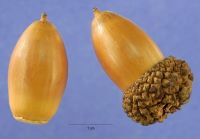 , 6–800 mm long, shape variable from hemisphericalhemispherical:
, 6–800 mm long, shape variable from hemisphericalhemispherical:
2D shape—shaped like half a sphere
to angularangular:
2D shape—having sides that meet at acute or obtuse angles
, tereteterete:
approximately circular in cross section; width and thickness approximately equal
 in transection, often stylestyle:
in transection, often stylestyle:
in a flower, the narrow and elongated part of the pistil between the stigma and the ovary; sometimes persisting in fruit persistent, often beakedbeak:
persistent, often beakedbeak:
a usually firm, terminal appendage, sometimes tapered . BerriesBerry:
. BerriesBerry:
an indehiscent, fleshy fruit with one or a few to many seeds. The flesh may be homogenous throughout. Or, if the outer part is hard, firm, or leathery, referred to as an hesperidium. Septa are present in some, and the seeds may be arillate or with a fleshy testa. one or sometimes 2–3(–10) seeded. Fruits are often simple, but aggregateaggregate:
one or sometimes 2–3(–10) seeded. Fruits are often simple, but aggregateaggregate:
fruit formed from a single flower with carpels several and distinct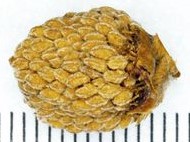 fruits occur in several genera. Fruits sometimes with persistent sepalssepal:
fruits occur in several genera. Fruits sometimes with persistent sepalssepal:
a member of the outer envelope of a flower (calyx) , petalspetal:
, petalspetal:
a member of the inner envelope of a flower (corolla)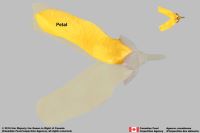 , imbricated scales, and/or staminodal ring. Pericarp black, brown, green, white, blue, orange, red, or yellow, shinyshiny:
, imbricated scales, and/or staminodal ring. Pericarp black, brown, green, white, blue, orange, red, or yellow, shinyshiny:
uniformly reflecting a high proportion of incident light at all angles or dulldull:
or dulldull:
reflecting only a low proportion of incident light, with no apparent sheen , fleshy or indurateindurate:
, fleshy or indurateindurate:
texture—hardened or stony; yielding under strong pressure; not deformable without internal structural disruption
, glabrousglabrous:
without hairs
or pubescentpubescent:
surface relief—bearing hairs
, smooth, scaly, fibrousfibrous:
texture—long, flexible threads, thicker than hairs, that densely cover and obscure the surface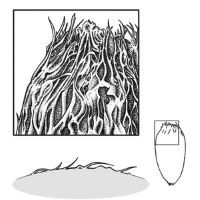 , wartywarty:
, wartywarty:
surface relief—distinct, rounded projections that are large relative to the fruit size; tuberculate, verrucose , wrinkledwrinkled:
, wrinkledwrinkled:
surface relief—shallow, irregular folds and furrows covering the surface; appearing overall though crumpled and then spread out , or spinyspiny:
, or spinyspiny:
having slender, stiff, sharp projections oriented in the general plane of the structure . Often the outer layers (epicarpepicarp:
. Often the outer layers (epicarpepicarp:
outer layer of fruit wall or pericarp, if divided into layers; note here used synonymously with exocarp and mesocarpmesocarp:
and mesocarpmesocarp:
the middle layer of the pericarp, if divided into layers ) are shed early and only the endocarpendocarp:
) are shed early and only the endocarpendocarp:
the inner layer of the pericarp, if divided into layers is present at dispersal. In fruits with differentiated endocarps, endocarps are thin (sometimes with operculaoperculum:
is present at dispersal. In fruits with differentiated endocarps, endocarps are thin (sometimes with operculaoperculum:
a dehiscent cap (or lid) of a seed or fruit that opens during germination or dehiscence ) to bonybony:
) to bonybony:
very hard and rather brittle, like bone
or thick and woodywoody:
texture—consisting mainly of indurate lignified tissues, characteristic of or resembling wood
(often with 1–3 pores).
Seeds globoseglobose:
3D shape—more or less spherical to kidney shapedkidney-shaped:
to kidney shapedkidney-shaped:
2D shape—broadly elongate and with one margin convex and the opposite side concave, each end bluntly rounded , tereteterete:
, tereteterete:
approximately circular in cross section; width and thickness approximately equal
 to plano-convexplano-convex:
to plano-convexplano-convex:
2D or 3D shape—flat on one side, convex on the other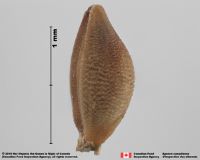 in transection, 3–50+ mm long, prominent operculaoperculum:
in transection, 3–50+ mm long, prominent operculaoperculum:
a dehiscent cap (or lid) of a seed or fruit that opens during germination or dehiscence or micropylarmicropyle:
or micropylarmicropyle:
an opening in the integuments of an ovule usually acting as a passage for the pollen tube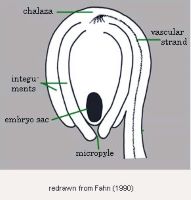 plugs, and often with conspicuous raphe variable in shape. Hilum short or to the length of the seed, apicalapical:
plugs, and often with conspicuous raphe variable in shape. Hilum short or to the length of the seed, apicalapical:
at or pertaining to the end of the seed or fruit distal from its point of attachment (i.e., base)
, laterallateral:
(of embryo) embryo lies along the side of the seed, generally towards one end; of, at, or from the side; in grasses, can refer to the sides adjacent to the dorsal and ventral sides
, or basalbasal:
at or pertaining to the point of attachment; (of embryo) embryo occupies one end of the seed
, linearlinear:
(shape) long, narrow, and uniform in width; (of embryo) embryo is straight and much longer than wide to circularcircular:
to circularcircular:
(of embryo) linear embryo is curved into an "O" shape . Several genera have seeds with a sarcotestasarcotesta:
. Several genera have seeds with a sarcotestasarcotesta:
pulpy or fleshy outer layer of the seed coat, simulates aril . Seed coat brown, shinyshiny:
. Seed coat brown, shinyshiny:
uniformly reflecting a high proportion of incident light at all angles , leatheryleathery:
, leatheryleathery:
texture—moderately thick, tough, and very pliable
or membranousmembranous:
texture—extremely thin, pliable, and fairly tough
, smooth or variously ornamented.
Embryo well developed, cylindricalcylindrical:
3D shape—a cylinder, with parallel sides and a circular cross-section; tubular or rod-shaped
or conical, curvedcurved:
(of embryo) linear embryo is curved into an arch or horseshoe with the ends far apart or straight, embedded in endosperm.
or straight, embedded in endosperm.
Endosperm copious, cartilaginouscartilaginous:
texture—firm, dense, tough, somewhat pliable, and resilient, like cartilage
or hard, homogenous or ruminateruminate:
testa or seed coat folded into the endosperm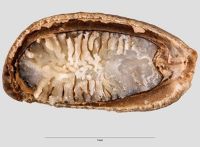 .
.
*For keys to the subfamilies, tribes, and genera as well as images and illustrations representing these groups, see Dransfield et al. 2008Dransfield et al. 2008:
Dransfield J, Uhl NW, Asmussen CB, Baker W, Harley MM, and Lewis CE. 2008. Genera Palmarum: The Evolution and Classification of Palms. Royal Botanic Gardens, Kew, London UK. 732 pp. https://doi.org/10.34885/92. This book is publicly available. Or, for identifying commonly cultivated palms, see Identifying Commonly Cultivated Palms.
Fruits frequently intercepted at ports.
| Fruit | |
| Type | berryberry: an indehiscent, fleshy fruit with one or a few to many seeds. The flesh may be homogenous throughout. Or, if the outer part is hard, firm, or leathery, referred to as an hesperidium. Septa are present in some, and the seeds may be arillate or with a fleshy testa.  , drupedrupe: , drupedrupe:(indehiscent drupe) a fleshy, indehiscent fruit with one more hard pits enclosing seeds, derived from single, superior, simple or compound ovary; (dehiscent drupe) a fruit with a dry or fibrous to fleshy or leathery outer husk that early to tardily breaks apart (or opens), exposing one or more nutlike pits enclosing the seeds  , nutnut: , nutnut:a fairly large, indehiscent, dry fruit with a thick and bony wall surrounding a single seed, derived from a single, simple or compound ovary  |
| Size range | 6–800 mm |
| Shape(s) | hemisphericalhemispherical: 2D shape—shaped like half a sphere , globoseglobose: 3D shape—more or less spherical  , oblateoblate: , oblateoblate:depressed globose , ovoidovoid: 3D shape—ovate  , ellipsoidellipsoid: , ellipsoidellipsoid:3D shape—elliptic , conicalconical: 3D shape—cone-shaped, with the point of attachment at the broad end  , teardrop-shapedteardrop-shaped: , teardrop-shapedteardrop-shaped:2D shape—widest point is toward one end of the fruit, the other end tapers sharply to a pointed end  , reniformreniform: , reniformreniform:2D or 3D shape—kidney-shaped  , lenticularlenticular: , lenticularlenticular:3D shape—lens-shaped; biconvex 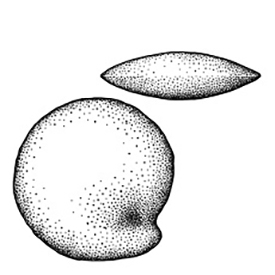 , angularangular: , angularangular:2D shape—having sides that meet at acute or obtuse angles |
| Texture | epicarpepicarp: outer layer of fruit wall or pericarp, if divided into layers; note here used synonymously with exocarp  - fleshy, woodywoody: - fleshy, woodywoody:texture—consisting mainly of indurate lignified tissues, characteristic of or resembling wood , or bonybony: very hard and rather brittle, like bone ; mesocarpmesocarp: the middle layer of the pericarp, if divided into layers  - thin, hard, fibrousfibrous: - thin, hard, fibrousfibrous:texture—long, flexible threads, thicker than hairs, that densely cover and obscure the surface  , dry or fleshy, oily; endocarpendocarp: , dry or fleshy, oily; endocarpendocarp:the inner layer of the pericarp, if divided into layers  , if present, thin or thick, bonybony: , if present, thin or thick, bonybony:very hard and rather brittle, like bone , woodywoody: texture—consisting mainly of indurate lignified tissues, characteristic of or resembling wood , fibrousfibrous: texture—long, flexible threads, thicker than hairs, that densely cover and obscure the surface  |
| Surface relief | smooth or scalyscaly: surface relief—covered with small, thin, fine scales or flakes that may be removable 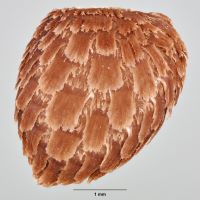 , fibrousfibrous: , fibrousfibrous:texture—long, flexible threads, thicker than hairs, that densely cover and obscure the surface  , wartywarty: , wartywarty:surface relief—distinct, rounded projections that are large relative to the fruit size; tuberculate, verrucose  , wrinkledwrinkled: , wrinkledwrinkled:surface relief—shallow, irregular folds and furrows covering the surface; appearing overall though crumpled and then spread out  , spinyspiny: , spinyspiny:having slender, stiff, sharp projections oriented in the general plane of the structure  |
| Color(s) | black, brown, green, white, blue, orange, red, yellow |
| Unique features | Fruits variable in this large family, usually one seeded, may be very large, corky-warted, scalyscaly: surface relief—covered with small, thin, fine scales or flakes that may be removable  , fibrousfibrous: , fibrousfibrous:texture—long, flexible threads, thicker than hairs, that densely cover and obscure the surface  , or covered in imbricate to reflexed scales. Fruits maybe fleshy but often those intercepted have a woodywoody: , or covered in imbricate to reflexed scales. Fruits maybe fleshy but often those intercepted have a woodywoody:texture—consisting mainly of indurate lignified tissues, characteristic of or resembling wood or bonybony: very hard and rather brittle, like bone outer coat and when cut open reveal a large seed with copious, hard or cartilaginouscartilaginous: texture—firm, dense, tough, somewhat pliable, and resilient, like cartilage endosperm (often ruminateruminate: testa or seed coat folded into the endosperm  ). ). |
| Seed | |
| Size range | 3–50+ mm |
| Shape(s) | hemisphericalhemispherical: 2D shape—shaped like half a sphere , globoseglobose: 3D shape—more or less spherical  , oblateoblate: , oblateoblate:depressed globose , ovoidovoid: 3D shape—ovate  , oblongoblong: , oblongoblong:2D shape—much longer than broad with nearly parallel sides, corners are rounded  , ellipsoidellipsoid: , ellipsoidellipsoid:3D shape—elliptic , cerebriformcerebriform: an irregular brain-like appearance, as the kernel of a walnut , reniformreniform: 2D or 3D shape—kidney-shaped  |
| Surface relief | wrinkledwrinkled: surface relief—shallow, irregular folds and furrows covering the surface; appearing overall though crumpled and then spread out  , reticulatereticulate: , reticulatereticulate:surface relief—netted, raised walls or concave grooves forming a net-like surface pattern with flat, concave, or convex interspaces  , ribbedribbed: , ribbedribbed:surface relief—wide, prominent, linear ridges that are generally rounded and longitudinally situated on the surface  , sculptured, veinedveined: , sculptured, veinedveined:surface relief—lines that intersect in a vein pattern that is flush or slightly raised from the surface 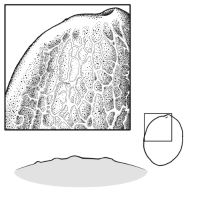 , wartywarty: , wartywarty:surface relief—distinct, rounded projections that are large relative to the fruit size; tuberculate, verrucose  |
| Color(s) | brown |
| Unique features | Seeds with prominent operculumoperculum: a dehiscent cap (or lid) of a seed or fruit that opens during germination or dehiscence  or micropylarmicropyle: or micropylarmicropyle:an opening in the integuments of an ovule usually acting as a passage for the pollen tube  plug. RaphaeRaphe: plug. RaphaeRaphe:a ridge or seam on the seed coat, formed by the portion of the funiculus united to the ovule wall in longitudinally curved ovules  often conspicuous and variable in shape, simple, forked, or branched and anastomosing or encircling the seeds. Hila small to the length of the seed, located apically, laterally, or basalbasal: often conspicuous and variable in shape, simple, forked, or branched and anastomosing or encircling the seeds. Hila small to the length of the seed, located apically, laterally, or basalbasal:at or pertaining to the point of attachment; (of embryo) embryo occupies one end of the seed and shaped from linearlinear: (shape) long, narrow, and uniform in width; (of embryo) embryo is straight and much longer than wide  to circularcircular: to circularcircular:(of embryo) linear embryo is curved into an "O" shape  . . |
| Other | |
| Embryo | well developed, cylindricalcylindrical: 3D shape—a cylinder, with parallel sides and a circular cross-section; tubular or rod-shaped or conicalconical: 3D shape—cone-shaped, with the point of attachment at the broad end  , curvedcurved: , curvedcurved:(of embryo) linear embryo is curved into an arch or horseshoe with the ends far apart  or straight, axile and central or peripheralperipheral: or straight, axile and central or peripheralperipheral:(of embryo) embryo is curved around the outer edge of the seed, near the seed coat in position and embedded in endosperm |
| Nutritive tissue | endosperm copious, sometimes ruminateruminate: testa or seed coat folded into the endosperm  , and sometimes with central hollow , and sometimes with central hollow |
Mostly pantropical, with subtropical and temperate species.
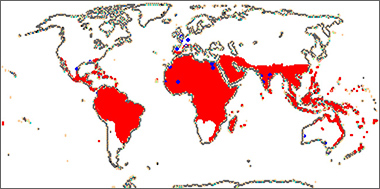
Distribution map courtesy of Angiosperm Phylogeny Website.
Baskin and Baskin 2021Baskin and Baskin 2021:
Baskin C and Baskin J. 2021. Relationship of the lateral embryo (in grasses) to other monocot embryos: A status up-grade. Seed Science Research 31 (3): 199-210. doi:10.1017/S0960258521000209; Dahlgren et al. 1985Dahlgren et al. 1985:
Dahlgren RMT, Clifford HT, and Yeo PF. 1985. The families of the monocotyledons: structure, evolution, and taxonomy. Springer-Verlag, Berlin. 520 pp.; Dransfield 1984Dransfield 1984:
Dransfield J. 1984. The genus Areca (Palmae: Arecoideae) in Borneo. Kew Bull. 39: 1-22.; Dransfield et al. 2008Dransfield et al. 2008:
Dransfield J, Uhl NW, Asmussen CB, Baker W, Harley MM, and Lewis CE. 2008. Genera Palmarum: The Evolution and Classification of Palms. Royal Botanic Gardens, Kew, London UK. 732 pp. https://doi.org/10.34885/92; Flora of Australia 2021+Flora of Australia 2021+:
Flora of Australia. Australian Biological Resources Study, Canberra. Accessed January 2021–March 2024. URL: http://www.ausflora.org.au; Flora of North America Editorial Committee 1993+Flora of North America Editorial Committee 1993+:
Flora of North America Editorial Committee, eds. 1993+. Flora of North America North of Mexico [Online]. 22+ vols. Flora of North America Association, New York and Oxford. Accessed January-March 2024. URL: http://beta.floranorthamerica.org.; Heatubun et al. 2014Heatubun et al. 2014:
Heatubun CD, Zona S, and Baker WJ. 2014. Three new genera of arecoid palm (Arecaceae) from eastern Malesia. Kew Bulletin 69 (3): 1-18. http://dx.doi.org/10.1007/S12225-014-9525-X; Kirkbride et al. 2006Kirkbride et al. 2006:
Kirkbride JH, Jr, Gunn CR, and Dallwitz MJ. 2006. Family guide for fruits and seeds, vers. 1.0. Accessed September 2020-January 2022. URL: https://nt.ars-grin.gov/seedsfruits/keys/frsdfam/index.cfm .; Kubitzki et al. 1990+Kubitzki et al. 1990+:
Kubitzki K et al., eds. 1990+. The families and genera of vascular plants. 7+ vols. Berlin etc.; Tropicos.org 2021+Tropicos.org 2021+:
Tropicos.org. 2021+. Pakistan Plant Database. Missouri Botanical Garden. Accessed January 2021–April 2024. http://legacy.tropicos.org/Project/Pakistan; Watson and Dallwitz 1992+Watson and Dallwitz 1992+:
Watson L and Dallwitz MJ. 1992+. The families of flowering plants: descriptions, illustrations, identification, and information retrieval. Version: 6th Accessed September 2020-September 2022. URL: delta-intkey.com; Zhengyi et al. 2004+Zhengyi et al. 2004+:
Zhengyi W, Raven PH, and Deyuan H. 2004+. Flora of China [online]. 25 vols. Science Press, Beijing China & Missouri Botanical Garden, St. Louis USA. Accessed January–March 2024. http://flora.huh.harvard.edu/china/
*The number of genera and species is based on Christenhusz and Byng 2016Christenhusz and Byng 2016:
Christenhusz MJM and Byng JW. 2016. The number of known plant species in the world and its annual increase. Phytotaxa 261 (3): 201-217. https://doi.org/10.11646/phytotaxa.261.3.1, which may differ from the number of genera in GRIN-Global.